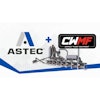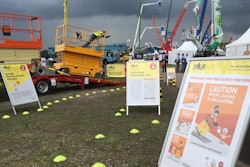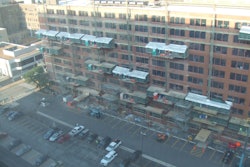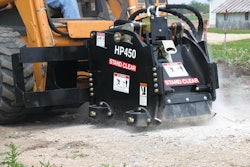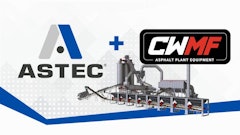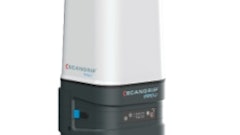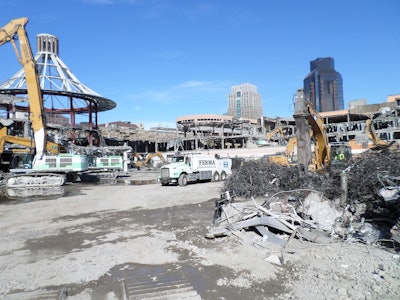
By Alexa Schlosser
Information from this article was first published in Demolition Magazine and is being reused with permission from the National Demolition Association.
For nearly seven years, there was a contentious battle over whether or not the Sacramento Kings would relocate to another city. In 2013, the NBA team’s new owners struck a deal with the city to keep the team in Sacramento and build a new arena. The community was thrilled. Not only would they be keeping their team and getting a new arena, but the Golden 1 Center would be one of the highest-tech stadium in sports.
The Sacramento Kings chose downtown Sacramento for the location of the new, multipurpose arena. In order to begin building the “21st century Colosseum,” as Kings owner Vivek Ranadive dubbed it, a large shopping center would have to be removed. The time frame was tight — the arena would need to be complete before the 2016-2017 NBA season — so the use of efficient and effective equipment was a must. NDA member FERMA was selected to perform the demolition because of its fleet strength, experience and specialty equipment.
The job officially began on July 31, 2014. FERMA was given a 65-day schedule to remove 1.7 million square feet of a five-story tensioned structure. In order to meet that deadline, the company had to work 12 hour shifts, six days a week. Using a combination of existing employees, local hires and apprentices, FERMA put together a crew of about 60 members, including estimators, project managers, a superintendent, foremen, operators, laborers, flaggers, teamsters, specialty mechanics and flaggers.
The company’s fleet size was ramped up for this project to include 12 skid steers, eight CAT 303 excavators with Hammers attachments, 12 CAT 336 excavators, one CAT 365 excavator, two CAT 375 excavators, two CAT 385 excavators, one CAT 5110 high-reach excavator, one Volvo EC480 high-reach excavator, four man lifts, one wall saw, two cranes of 90 and 350 for debris maintenance, and two shredders — named “Big Dog” and “Little Dog” — for on-site material processing.
The demolition stages were very methodical for safety, space and production reasons. First, to make space that was needed to move large machines into the jobsite, FERMA demolished a smaller building with some of its smaller machines. Once the heavy artillery was in place, the production took off. The bigger machines with sheer and concrete processor tools performed the large demolition; smaller machines performed the processing of the material (concrete, rebar, steel and other debris) in FERMA’s two crushers. Having the smaller machines work in tandem with the larger machines helped improve the efficiency of daily production.
“The strategy that FERMA employs is the use of high-reach equipment that allows the demolition to occur not only in a productive manner, but also a safe manner, as the operator maintains a safe distance away from the demolition,” says Ameet Patel, FERMA project manager. “Additionally, the demolition has to occur in a fashion that allows materials to be sorted by mechanical means to maintain diversion goals and minimize disposal at landfills.”
The demolition itself was fairly straightforward. The complexities arose from other factors, such as the number of entities working simultaneously, the tight schedule and heat waves of over 100 degrees Fahrenheit.
“To complete the demolition within the allocated schedule took a great deal of planning and communication with our project management team, superintendent and on several on-site foremen,” Patel says.
Due to the project’s size and intricacies, FERMA also had an on-site safety coordinator. The company implemented a heat illness prevention plan (HIPP) with hydration stations and intervention for any employee that felt heat stroke symptoms.
In addition to the heat concerns, safety was important during high-reach work.
“During high-reach work, FERMA typically has a dedicated spotter on a aerial boom lift to provide a better visual for the demolition that is then communicated to the operator in real time using radios,” Patel says.
Ultimately, FERMA chalked this job up as a “complete success,” says FERMA’s Carrie Gerton. “We were able to achieve the goals we set for ourselves and delivered on the project milestones set forth by the general contractor, all while maintaining employee safety.”

